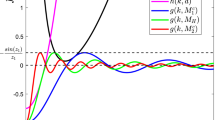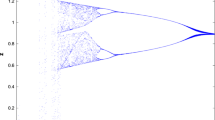Abstract
The evolutionary responses of predators to prey and of prey to predators are analysed using models for the dynamics of a quantitative trait that determines the capture rate of prey by an average searching predator. Unlike previous investigations, the analysis centres on models and/or parameter values for which the two-species equilibrium is locally unstable. The instability in some models is driven by the predator's non-linear functional response to prey; in other models, the cycles are a direct consequence of evolutionary response to selection acting on the trait. When the values of predator and prey traits combine multiplicatively to determine the capture rate, the predator's trait shows only a transient response to changes in the prey's trait in stable systems. However, when the population densities exhibit sustained oscillations, predators often evolve an increased long-term mean capture rate in response to an increased prey escape ability. Under the multiplicative model, prey in stable systems always evolve increased escape ability in response to an increased predator capture a
Similar content being viewed by others
References
Abrams, P.A. (1986) Adaptive responses of predators to prey and prey to predators: The failure of the arms race analogy. Evolution, 40, 1229–1247.
Abrams, P.A. (1990) The evolution of antipredator traits in prey in response to evolutionary change in predators. Oikos 59, 147–156.
Abrams, P.A. (1991) The effects of interacting species on predator-prey coevolution. Theor. Pop. Biol. 39, 241–262.
Abrams, P.A. (1992) Adaptive foraging by predators as a cause of predator-prey cycles. Evol. Ecol. 6, 56–72.
Abrams, P.A. and Matsuda, H. (1996) Fitness minimization and dynamic instability as a consequence of predator-prey coevolution. Evol. Ecol. 10, 167–186.
Abrams, P.A. and Matsuda, H. (in press) Prey evolution as a cause of predator-prey cycles. Evolution.
Abrams, P.A. and Roth, J.D. (1994a) The responses of unstable food chains to enrichment. Evol. Ecol. 8, 150–171.
Abrams, P.A. and Roth, J.D. (1994b) The effects of enrichment on three-species food chains with nonlinear functional responses. Ecology 75, 1118–1130.
Abrams, P.A., Matsuda, H. and Harada, Y. (1993) Unstable fitness maxima and stable fitness minima in the evolution of continuous traits. Evol. Ecol. 7, 465–487.
Brodie, E.D. III and Brodie, E.D. Jr (1991) Evolutionary response of predators to dangerous prey: Reduction of toxicity of newts and resistance of garter snakes in island populations. Evolution 45, 221–224.
Cohen, J.E., Briand, F. and Newman, C.E. (1990) Community Food Webs: Data and Theory. Springer, Berlin.
Dawkins, R. and Krebs, J.R. (1979) Arms races between and within species. Proc. R. Soc. Lond. B 205, 489–511.
Dieckmann, U., Marrow, P. and Law, R. (1995) Evolutionary cycling in predator-prey interactions: Population dynamics and the Red Queen. J. Theor. Biol. 176, 91–102.
Ellner, S. and Turchin, P. (1995) Chaos in a noisy world: New methods and evidence from time-series analysis. Am. Nat. 145, 343–375.
Endler, J.A. (1986) Natural Selection in the Wild. Princeton University Press, Princeton, NJ.
Gilpin, M.E. (1975) Group Selection in Predator-Prey Communities. Princeton University Press, Princeton, NJ.
Hastings, A. and Powell, T. (1991) Chaos in a three-species food chain. Ecology 72, 896–903.
Iwasa, Y., Pomiankowski, A. and Nee, S. (1991) The evolution of costly mate preferences: II. The ‘handicap’ principle. Evolution, 45, 1431–1442.
Lande, R. (1976) Natural selection and random genetic drift in phenotypic evolution. Evolution 30, 314–334.
Lima, S.L. and Dill, L.M. (1990) Behavioural decisions made under the risk of predation: A review and prospectus. Can. J. Zool. 68, 619–640.
Matsuda, H. and Abrams, P.A. (1994) Timid consumers: Self-extinction due to adaptive change in foraging and anti-predator effort. Theor. Pop. Biol. 45, 76–91.
Press, W.H., Flannery, B.P., Teukolsky, S.A. and Vetterling, W.T. (1986) Numerical Recipes. Cambridge University Press, Cambridge.
Rinaldi, S., Muratori, S. and Kuznetsov, Y. (1992) Multiple attractors, catastrophes and chaos in seasonally perturbed predator-prey communities. Bull. Math. Biol. 55, 15–35.
Rosenzweig, M.L. (1973) Evolution of the predator isocline. Evolution 27, 84–94.
Rosenzweig, M.L. and Schaffer, W.M. (1978) Homage to the Red Queen: II. Coevolutionary response to enrichment of exploitation ecosystems. Theor. Pop. Biol. 9, 158–163.
Roughgarden, J. (1979) Theory of Population Genetics and Evolutionary Ecology. Macmillan, New York.
Roughgarden, J. (1983) The theory of coevolution. In Coevolution (D.J. Futuyma and M. Slatkin, eds), pp. 33–64. Sinauer Associates, Sunderland, MA.
Saloniemi, I. (1993) A coevolutionary predator-prey model with quantitative characters. Am. Nat. 141, 880–896.
Schaffer, W.M. and Rosenzweig, M.L. (1978) Homage to the Red Queen: I. Coevolution of predators and their victims. Theor. Pop. Biol. 14, 135–157.
Seger, J. (1992) Evolution of exploiter-victim relationships. In Natural Enemies (M. Crawley, ed.), pp. 3–26. Blackwell, Oxford.
Stephens, D.W. and Krebs, J.R. (1986) Foraging Theory. Princeton University Press, Princeton, NJ.
Taper, M. and Case, T.J. (1992) Models of character displacement and the theoretical robustness of taxon cycles. Evolution 46, 317–334.
Taylor, P.D. (1989) Evolutionary stability in one-parameter models under weak selection. Theor. Pop. Biol. 36, 125–143.
Taylor, R.J. (1984) Predation. Chapman and Hall, New York.
Turchin, P. and Taylor, A.D. (1992) Complex dynamics in ecological time-series. Ecology 73, 289–305.
Vermeij, G.J. (1994) The evolutionary interaction among species: Selection, escalation, and coevolution. Ann. Rev. Ecol. Syst. 25, 219–236.
Vincent, T.L., Cohen, Y. and Brown, J.S. (1993) Evolution via strategy dynamics. Theor. Pop. Biol. 44, 149–176.
Yodzis, P. and Innis, S. (1992) Body size and consumer-resource dynamics. Am. Nat. 139, 1151–1175.
Author information
Authors and Affiliations
Rights and permissions
About this article
Cite this article
Abrams, P.A. Evolutionary responses of foraging-related traits in unstable predator–prey systems. Evolutionary Ecology 11, 673–686 (1997). https://doi.org/10.1023/A:1018482218068
Issue Date:
DOI: https://doi.org/10.1023/A:1018482218068




